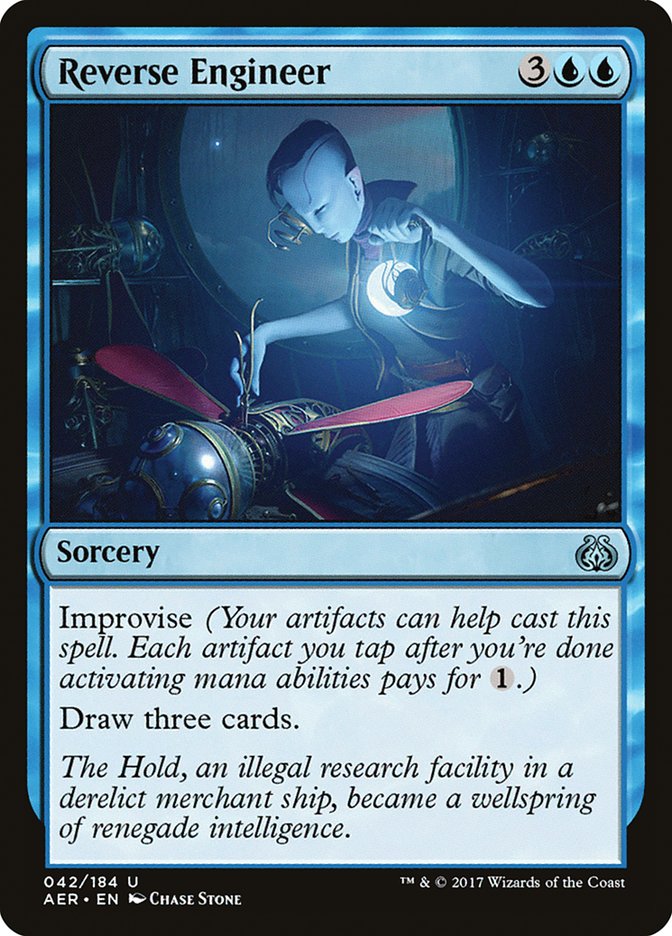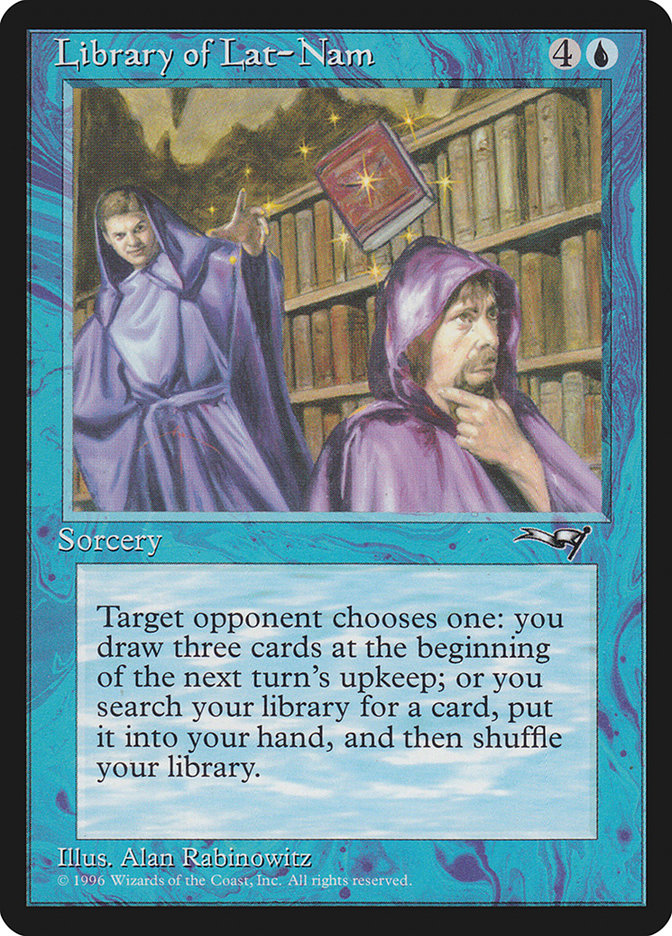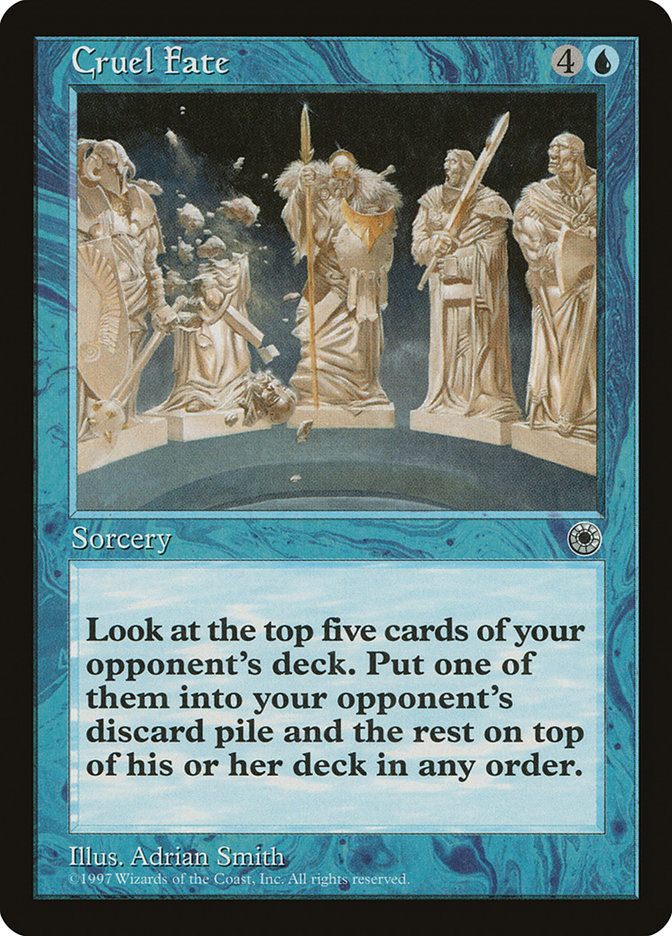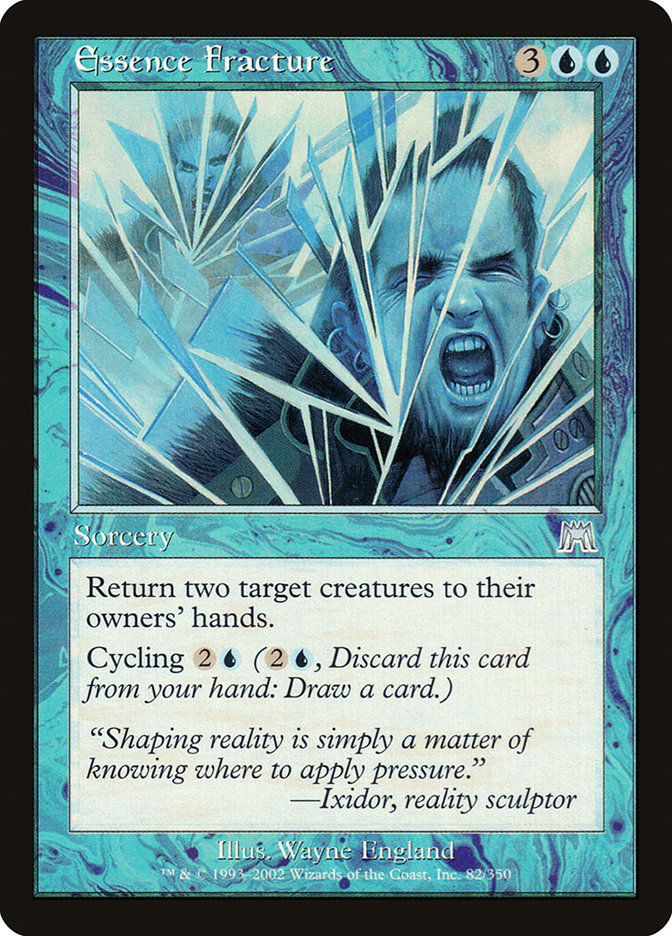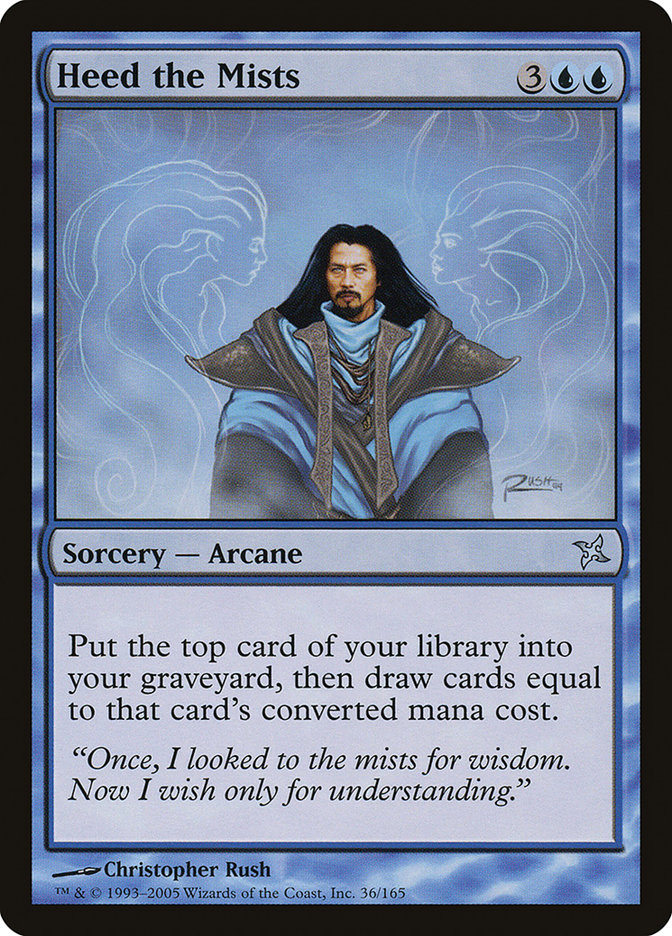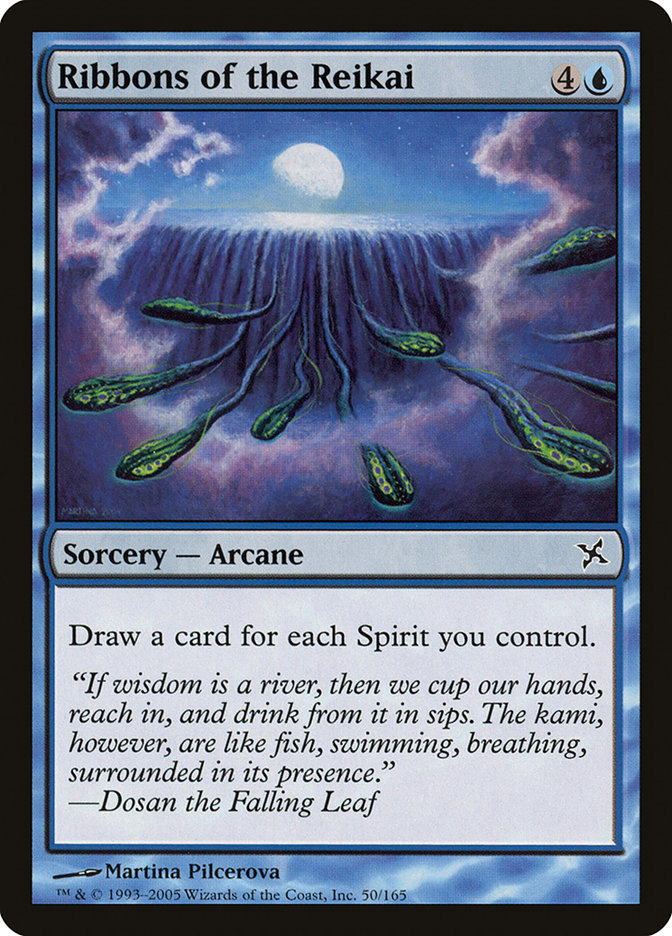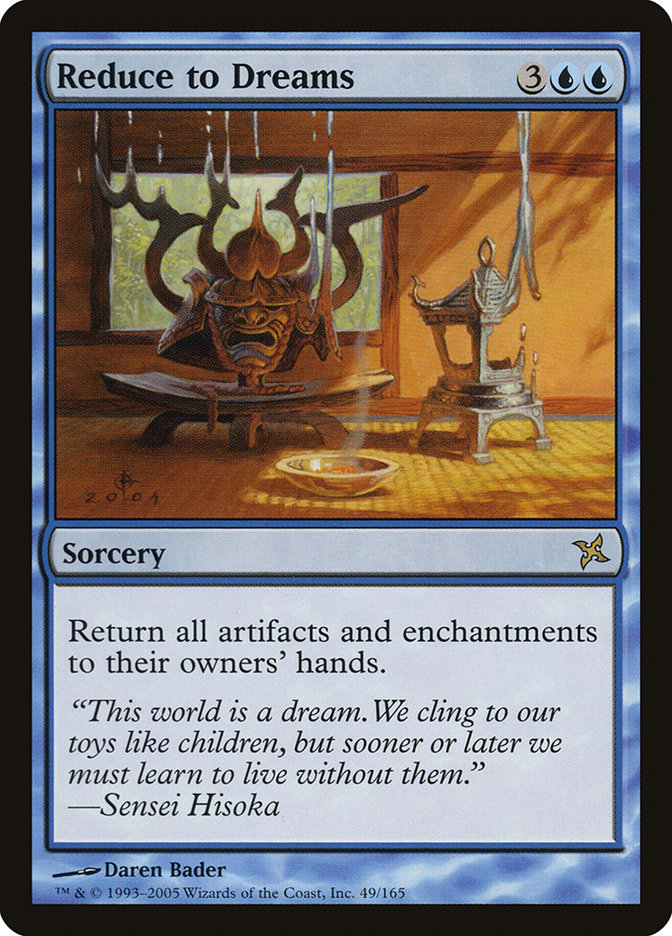Reverse Engineer MTG Card
| Card sets | Released in 7 setsSee all |
| Mana cost | |
| Converted mana cost | 5 |
| Rarity | Uncommon |
| Type | Sorcery |
| Abilities | Improvise |
Text of card
Improvise (Your artifacts can help cast this spell. Each artifact you tap after you're done activating mana abilities pays for .) Draw three cards.
The Hold, an illegal research facility in a derelict merchant ship, became a wellspring of renegade intelligence.
Cards like Reverse Engineer
Reverse Engineer is an intriguing card in the realm of Magic: The Gathering, offering a unique “draw three cards” mechanic. It rubs shoulders with similar uncommon cards like Concentrate, which also provides the bonus of drawing three cards. Reverse Engineer, however, shines with its improvise mechanic, allowing players to tap artifacts in lieu of mana costs, an exclusive perk not found with Concentrate.
In the same family, we find Thirst for Knowledge. Like Reverse Engineer, it uses the artifact mechanic but requires the discard of an artifact or two cards instead, which might be less advantageous. Another similar card is Read the Runes, which shares the draw mechanic and involves similar risks with its discard rule. Unlike Reverse Engineer, it lacks the flexibility of the improvise mechanism.
After comparing these attributes and understanding the value of each card, it is clear how Reverse Engineer distinguishes itself among other Magic: The Gathering cards. Its versatility with the improvise mechanic and its ability to override mana costs with artifact usage significantly enhance its position among its peers.
Cards similar to Reverse Engineer by color, type and mana cost
Decks using this card
MTG decks using Reverse Engineer. Dig deeper into the strategy of decks, sideboard cards, list ideas and export to play in ARENA or MOL.
| # | Name | Format | Archetype | Event |
|---|---|---|---|---|
 | Jeskai Affinity | Pauper | Jeskai Affinity | Pauper Challenge 64 2024-03-24 |
 | Azorius Affinity | Pauper | Azorius Affinity | Pauper League 2024-03-11 |
 | Esper Midrange | Pauper | Esper Affinity | BLUE - SAT - 1PM - Chicago Pauper Cup |
 | Esper Affinity | Pauper | Esper Affinity | Tappa N°6 Lega Pauper Versilia |
 | Esper Glitter Affinity | Pauper | Esper Affinity | Monthly Tournament #33 |
Card Pros
Card Advantage: Invigorate your game with Reverse Engineer, an exceptional card that provides significant advantage, specifically, it allows you to draw three cards instead of one. This is valuable in sustaining or gaining dominance over the card pool in play.
Resource Acceleration: Costing lesser mana with its Improvise ability, Reverse Engineer brings forth an interesting resource acceleration mechanism. By using Artifacts lying under your command, you can trigger the spell easier and faster, providing an early lead or a quick comeback.
Instant Speed: Although, Reverse Engineer might not be an instant speed card, it compensates with a powerful effect that you can trigger in your turn’s main phases. Strategise and plan, unpacking your opponent’s play and strategising a comeback is effortlessly enabled by this unique card.
Card Cons
Discard Requirement: When you use a Reverse Engineer card, it calls for a discard setup. While kickstarting the card’s effect, an extra cost surfaces, involving you to forfeit a card. It’s a negative aspect, mainly when your arsenal contains minimal resources. The discard requirement can limit your game strategies and impact your victory chances.
Specific Mana Cost: The effectiveness of a Reverse Engineer relies on a distinct mana color—Blue. The requirement restricts its adaptability for various decks, hence barricading multifarious game tactics. Thus, this card could become a bottleneck in diverse game scenarios.
Comparatively High Mana Cost: The usage of Reverse Engineer is pegged at a mana cost of five. When juxtaposed with other cards, this figure appears quite high. For an equivalent or lower price, other cards offer more efficient resource acquisition or card draw options, rendering Reverse Engineer less appealing.
Reasons to Include in Your Collection
Versatility: The Reverse Engineer card presents wide adaptability. As it draws additional cards for players, this card synergizes with blue decks, which are typically more prominent in controlling the tempo and disrupting opponents’ strategies.
Combo Potential: By employing the Improvise mechanic, the Reverse Engineer card cunningly interacts with artifact decks. This allows players to tap their artifacts to pay mana cost, thereby enhancing your strategies in situations where these decks are crucial.
Meta-Relevance: Within the current meta-game, the Reverse Engineer card is highly valued. Being able to gain card advantage is crucial in matches, especially in control or mid-range types of decks, where strategy and foresight play a significant role.
How to beat
Reverse Engineer is a unique card draw spell in MTG. The card utilizes a special mechanic called Improvise which can reduce its casting cost significantly. Similar to cards like Thirst for Knowledge, Reverse Engineer provides quick card draw, significantly impacting the game dynamics. However, contrary to Thirst for Knowledge, there is no prerequisite to discard any of your cards.
Take for instance, the card Artificer’s Intuition. Although it also revolves around artifacts, it inadvertently aids in fueling your hand at the cost of a single artifact from your hand. The advantage with Reverse Engineer is its ability to draw three cards instantly, without the need for any sacrifices or additional mana. Contrastingly, Stoic Rebuttal can counteract Reverse Engineer’s ability but must need metalcraft to be effective.
In summary, several strategies and cards can counteract Reverse Engineer, but its capacity for instantaneous draw power, without the need for further sacrifices or paying additional mana, places it fairly in the deck of blue artifact-oriented decks. Understanding the game mechanics behind these cards gives players an advantage and a strategy to effectively combat Reverse Engineer in any MTG gameplay.
BurnMana Recommendations
Dive deeper into the mechanics of MTG and enhance your deck-building skills with Reverse Engineer. This card epitomizes strategic depth, offering card draw power that few can match. Whether you’re overcoming a slow start, seeking the perfect combo piece, or simply replenishing your hand, the benefits of Reverse Engineer can’t be overstated in a well-crafted blue artifact deck. With its Improvise ability, it not only accelerates your resources, but also fits seamlessly into various strategies, highlighting its meta-relevance. If you’re eager to expand your MTG knowledge and refine your gameplay, join us for more insights and master the art of using cards like Reverse Engineer to their fullest potential.
Where to buy
If you're looking to purchase Reverse Engineer MTG card by a specific set like Magic Online Promos and Friday Night Magic 2017, there are several reliable options to consider. One of the primary sources is your local game store, where you can often find booster packs, individual cards, and preconstructed decks from current and some past sets. They often offer the added benefit of a community where you can trade with other players.
For a broader inventory, particularly of older sets, online marketplaces like TCGPlayer, Card Kingdom and Card Market offer extensive selections and allow you to search for cards from specific sets. Larger e-commerce platforms like eBay and Amazon also have listings from various sellers, which can be a good place to look for sealed product and rare finds.
Additionally, Magic’s official site often has a store locator and retailer lists for finding Wizards of the Coast licensed products. Remember to check for authenticity and the condition of the cards when purchasing, especially from individual sellers on larger marketplaces.
Below is a list of some store websites where you can buy the Reverse Engineer and other MTG cards:
 BUY NOW
BUY NOW BurnMana is an official partner of TCGPlayer
- eBay
- Card Kingdom
- Card Market
- Star City Games
- CoolStuffInc
- MTG Mint Card
- Hareruya
- Troll and Toad
- ABU Games
- Card Hoarder Magic Online
- MTGO Traders Magic Online
See MTG Products
Printings
The Reverse Engineer Magic the Gathering card was released in 7 different sets between 2017-01-20 and 2023-08-04. Illustrated by 2 different artists.
| # | Released | Name | Code | Symbol | Number | Frame | Layout | Border | Artist |
|---|---|---|---|---|---|---|---|---|---|
| 1 | Magic Online Promos | PRM | 64995 | 2015 | Normal | Black | Jason Kang | ||
| 2 | Friday Night Magic 2017 | F17 | 7 | 2015 | Normal | Black | Jason Kang | ||
| 3 | 2017-01-20 | Aether Revolt | AER | 42 | 2015 | Normal | Black | Chase Stone | |
| 4 | 2018-08-09 | Commander 2018 | C18 | 99 | 2015 | Normal | Black | Chase Stone | |
| 5 | 2021-05-27 | Historic Anthology 5 | HA5 | 7 | 2015 | Normal | Black | Chase Stone | |
| 6 | 2023-04-21 | March of the Machine Commander | MOC | 232 | 2015 | Normal | Black | Chase Stone | |
| 7 | 2023-08-04 | Commander Masters | CMM | 116 | 2015 | Normal | Black | Chase Stone |
Legalities
Magic the Gathering formats where Reverse Engineer has restrictions
| Format | Legality |
|---|---|
| Historicbrawl | Legal |
| Historic | Legal |
| Legacy | Legal |
| Paupercommander | Legal |
| Oathbreaker | Legal |
| Gladiator | Legal |
| Pioneer | Legal |
| Commander | Legal |
| Modern | Legal |
| Pauper | Legal |
| Vintage | Legal |
| Duel | Legal |
| Explorer | Legal |
| Penny | Legal |
| Timeless | Legal |
Rules and information
The reference guide for Magic: The Gathering Reverse Engineer card rulings provides official rulings, any errata issued, as well as a record of all the functional modifications that have occurred.
| Date | Text |
|---|---|
| 2018-07-13 | Equipment attached to a creature doesn't become tapped when that creature becomes tapped, and tapping that Equipment doesn't cause the creature to become tapped. |
| 2018-07-13 | If an artifact you control has a mana ability with in the cost, activating that ability while casting a spell with improvise will result in the artifact being tapped when you pay the spell's costs. You won't be able to tap it again for improvise. Similarly, if you sacrifice an artifact to activate a mana ability while casting a spell with improvise, that artifact won't be on the battlefield when you pay the spell's costs, so you won't be able to tap it for improvise. |
| 2018-07-13 | Improvise can't be used to pay for anything other than the cost of casting the spell. For example, it can't be used during the resolution of an ability that says “Counter target spell unless its controller pays .” |
| 2018-07-13 | Improvise can't pay for , , , , , or mana symbols in a spell's total cost. |
| 2018-07-13 | Improvise doesn't change a spell's mana cost or mana value. |
| 2018-07-13 | Tapping an artifact won't cause its abilities to stop applying unless those abilities say so. |
| 2018-07-13 | When calculating a spell's total cost, include any alternative costs, additional costs, or anything else that increases or reduces the cost to cast the spell. Improvise applies after the total cost is calculated. |
| 2018-07-13 | When using improvise to cast a spell with in its mana cost, first choose the value for X. That choice, plus any cost increases or decreases, will determine the spell's total cost. Then you can tap artifacts you control to help pay that cost. For example, if you cast Saheeli's Directive and choose X to be 3, the total cost is . If you tap two artifacts, you'll have to pay . |
